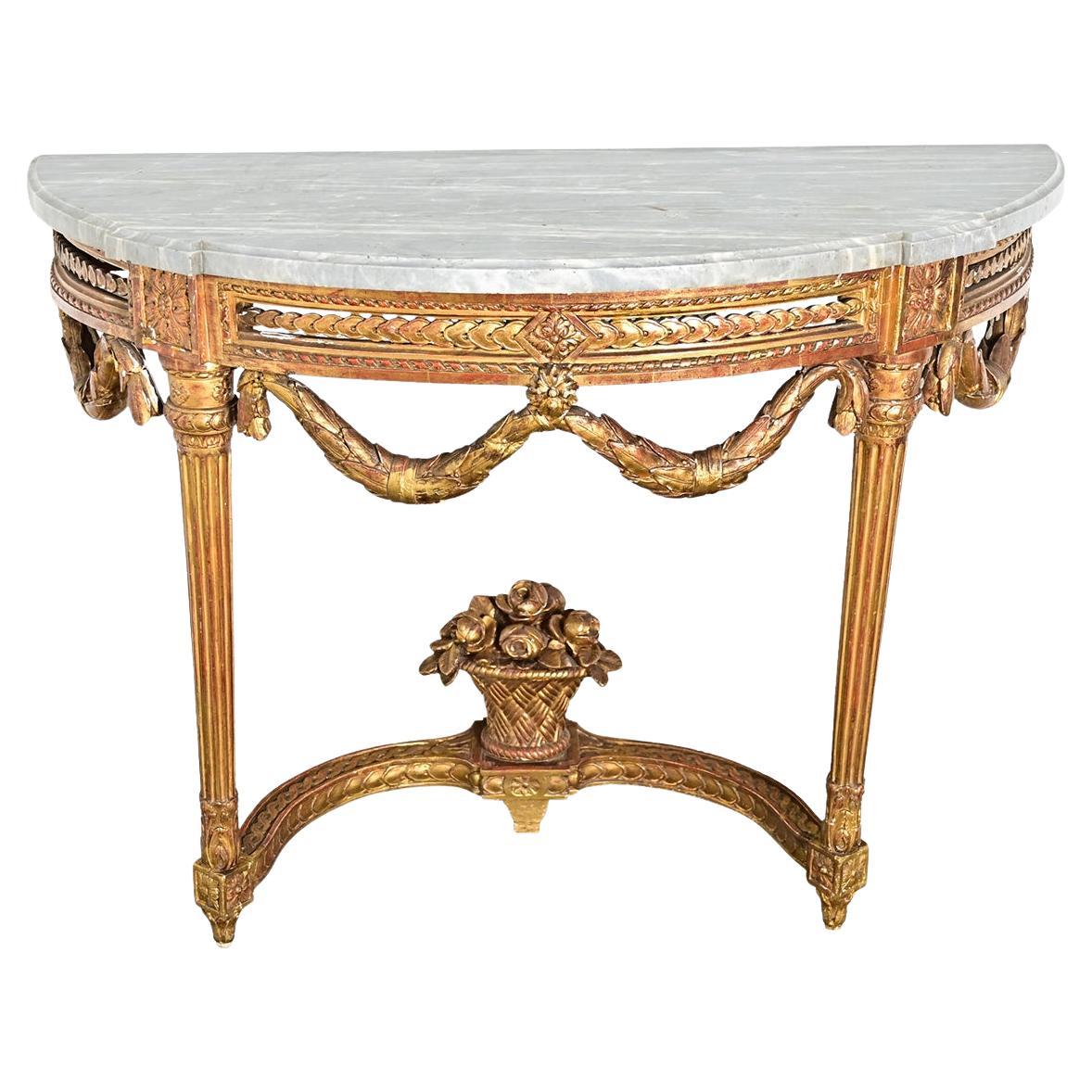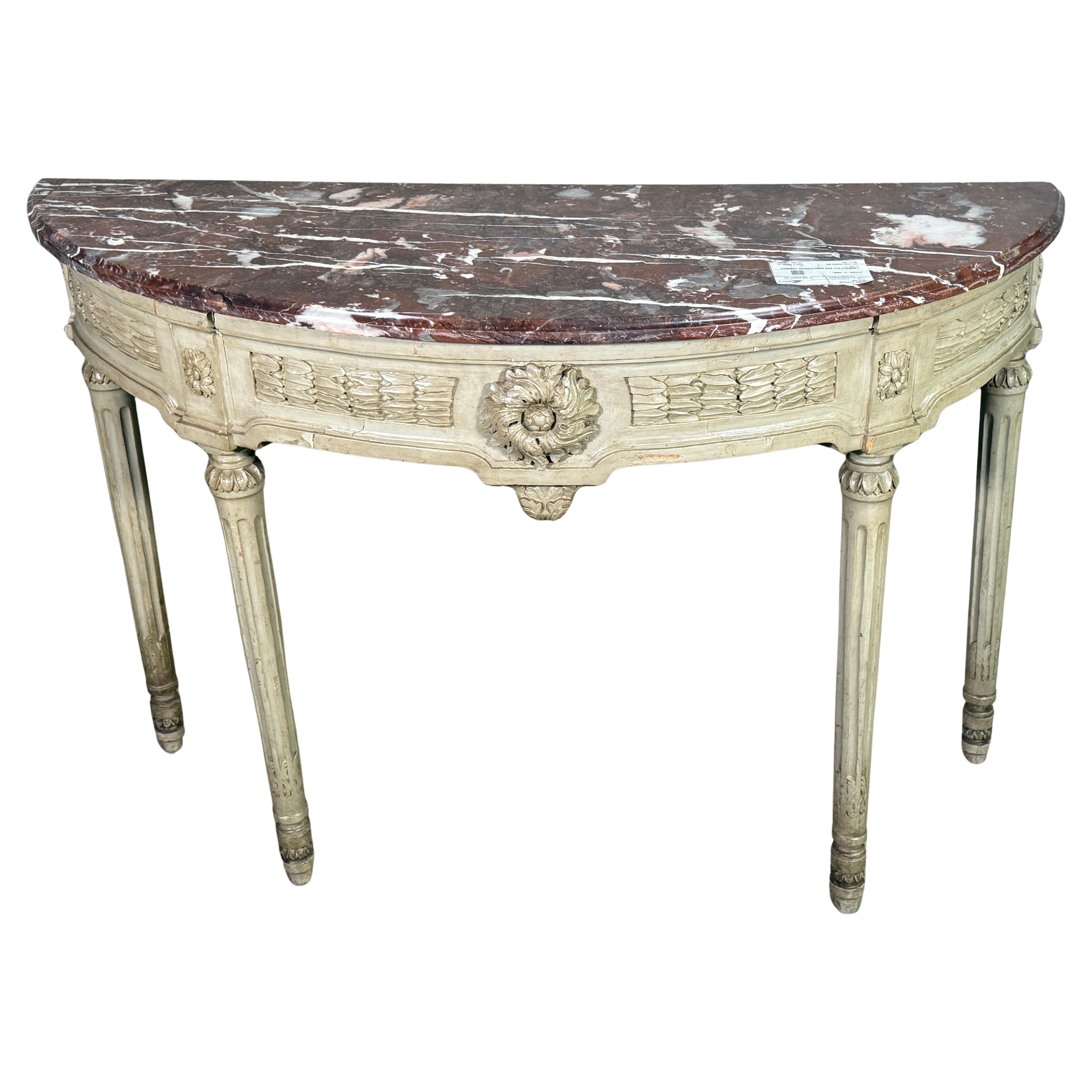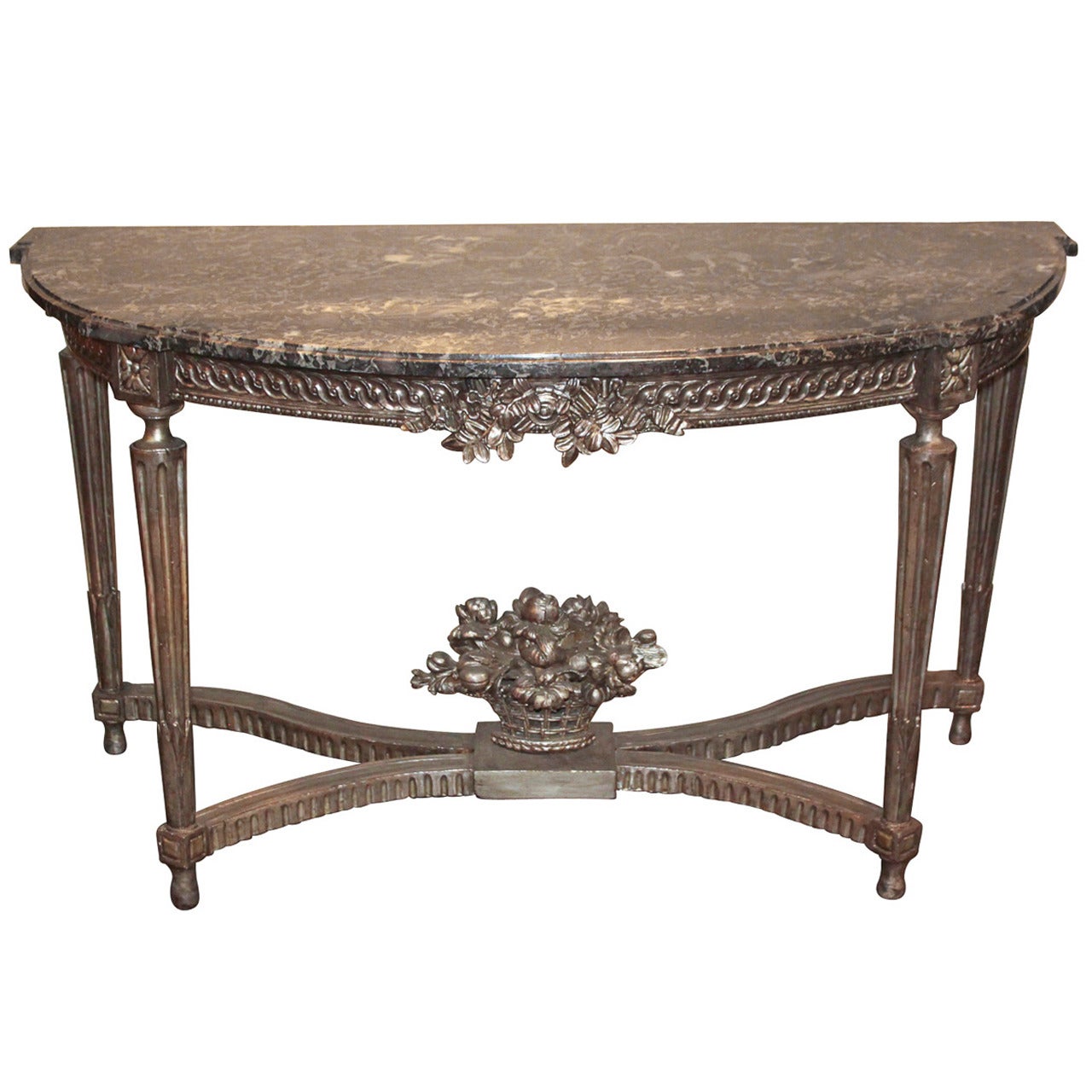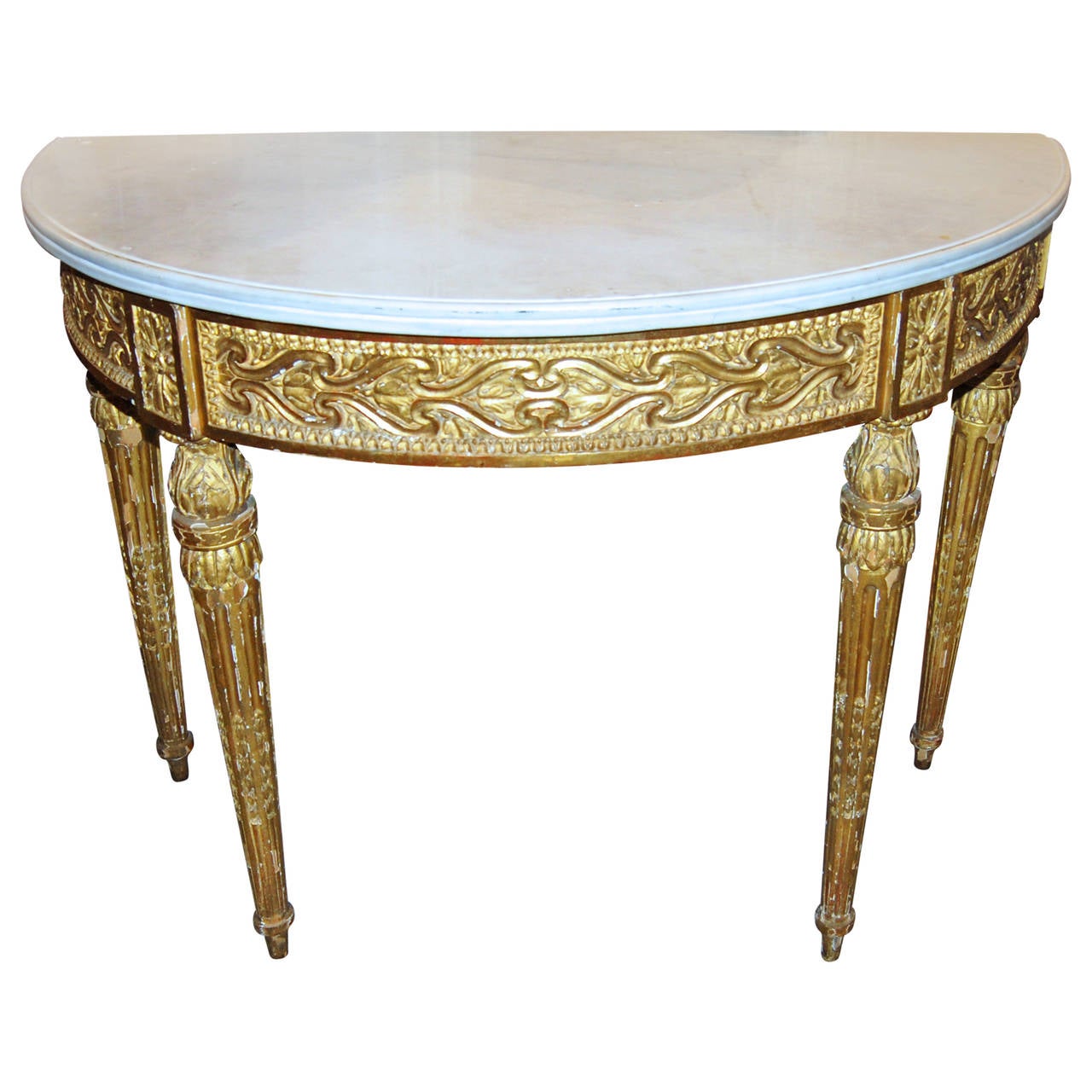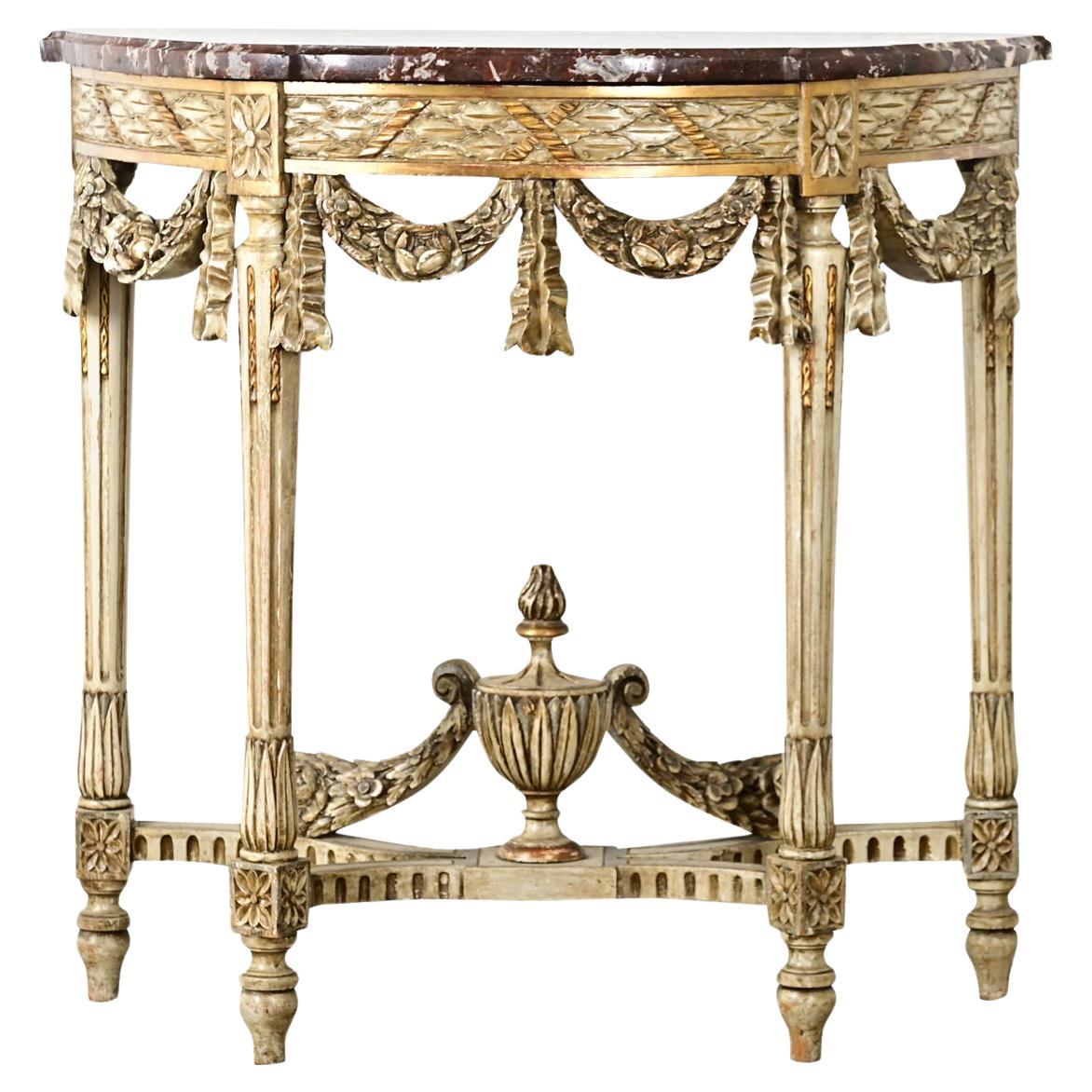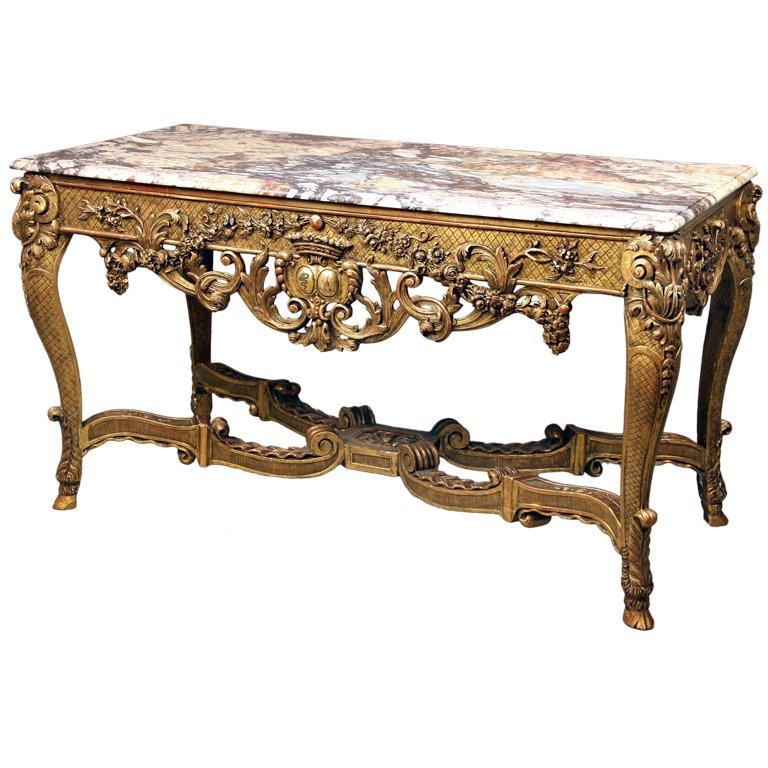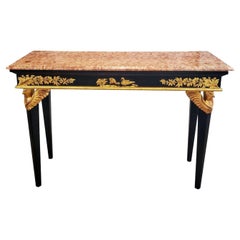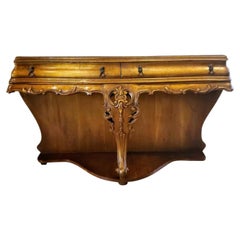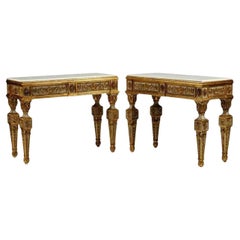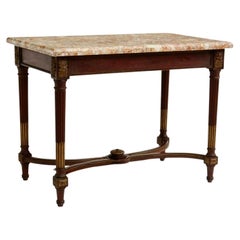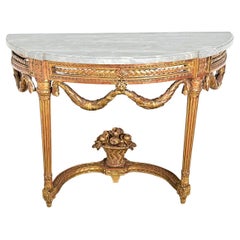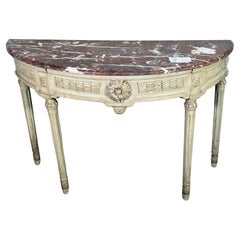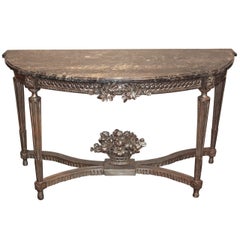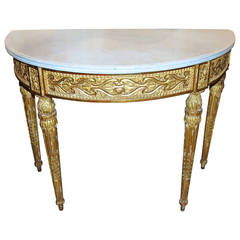Items Similar to Large French Louis XVI Style Maison Jansen Attrib Console Table Buffet Sever
Want more images or videos?
Request additional images or videos from the seller
1 of 37
Large French Louis XVI Style Maison Jansen Attrib Console Table Buffet Sever
$11,995per item
£9,340.91per item
€10,625.25per item
CA$17,274.80per item
A$18,956.94per item
CHF 9,901.30per item
MX$226,651.24per item
NOK 125,417.51per item
SEK 116,975.43per item
DKK 79,355.74per item
Quantity
About the Item
A large and most impressive vintage French Louis XVI style painted parcel gilt console table / server attributed to legendary Parisian design house Maison Jansen.
*Rare opportunity! Please note, at the time of writing this, we have a second matching example / pair of two available. Available separately / priced each. Pieces like this are exceedingly difficult to find in pairs*
Crafted in Paris, France, 20th century, exceptionally executed in refined, opulent and luxurious Neoclassical inspired 18th century King Louis 16th taste, monumental size, featuring a massive thick demilune shaped rouge red marble top with dramatic white and gray veining, projecting canted corners and smooth stepped molded edge, over conforming bow front solid wood frame in chic distressed antique white cream with brilliant gilded accents, raised on ornate projecting carved giltwood scroll supports, tiered with large open shelf, squared cross-stretcher joined tapered fluted legs adorned in intricate acanthus leaf carvings, terminating in arrow feet.
Dimensions: (approx)
36" High, 96" Wide, 34" Deep
Having the ideal palatial size and proportions for a variety of different uses, including as a hall console, dining room sideboard or buffet serving table, perhaps placed in the foyer of a grand hotel, aristocratic manor house or luxurious resort, or flanking the entry of a magnificent opera house or ballroom. A true statement piece, wherever it's placed, it's sure to add classic elegance, opulence, romantic warmth and timeless sophistication to any space!
About Maison Jansen / History:
by 1stDibs Editors
The fabled decorating firm Maison Jansen opened its doors in Paris, in 1880. Its founder was a young Dutchman in his mid-twenties by the name of Jean-Henri Jansen. His origins are a bit of a mystery, though it’s suspected he must have apprenticed at a prestigious architecture or decorating firm, as he seems to have had an extensive network of high-level contacts from the moment he set up his business.
What’s certain is that he was an enormously talented decorator, entrepreneur and publicist because Maison Jansen quickly became a leading tastemaker and remained one for the next century. Thanks to his efforts, Jansen became the first international design firm. When he died in 1928, Maison Jansen had outposts in major cities throughout the world: London, New York, Buenos Aires, Cairo, Havana, Prague, Rome and Rio de Janeiro.
Maison Jansen quickly established its name by participating in some of Europe’s most influential fairs, beginning with the 1883 International Colonial Exposition in Amsterdam. Invited to exhibit in the French pavilion, the firm displayed regal Louis-style settings that played up the refined supremacy of Gallic taste, earning it a silver medal.
Its expertise in mixing period majesty with updated comforts became something of a calling card, opening many palace doors during its years of service. King Willem III of the Netherlands and King Alfonso XII of Spain were among Jansen’s earliest clients. Then came King Leopold II of Belgium, who commissioned the firm to decorate the new interiors of Château du Laeken, after the royal family residence had been nearly destroyed in a fire. An enormous project, it was not fully completed until the 1960s!
Great Britain’s King Edward VII utilized the firm’s services when he decided to update the Victorian décor at Buckingham Palace, as did King Edward VIII, although Jansen’s decorative schemes for his private rooms were never realized as he departed the palace so soon after he ascended the throne!
Egypt’s King Farouk and his family were clients, as was the Shah of Iran, who commissioned the firm to design the spectacular celebration of the 2,500th anniversary of the Persian empire, at the ancient ruins of Persepolis, in 1971. The sumptuous four-day affair took a decade to plan, but ironically, the event’s wild extravagance — it cost a rumored $50 million — fueled the revolutionary fervor against the Shah, contributing to his eventual overthrow.
Due to the elevated status of so many of its clients, Jansen’s approach to decorating was different from that of the great “lady decorators” of the early 20th century — Elsie de Wolfe, Syrie Maugham, and Sibyl Colefax — who were at times the firm’s competitors as well as collaborators.
For example, Elsie de Wolfe commissioned the Jansen decorator Stéphane Boudin to design her legendary 1938 Circus Ball, as well as the party pavilion she added to Villa Trianon, her country house outside Paris. She also received a percentage of the commissions from any clients she sent its way.
While the wealthy went to these women for their smart taste and vision, those who sought out the Paris-based design firm didn’t want a decorator’s stamp on their homes. “It was not proper for one to overshadow the client,” Claude Mandron, a former decorator at the firm, told James Archer Abbott, the author of Jansen (Acanthus Press, 2006).
Decorators were there to “assist,” which was why, he explained, you “rarely see a period credit assigned to a Jansen interior.” Of course, in reality, the complexity of the projects Maison Jansen handled and their sophistication were far beyond the talents, and possibly taste, of your average monarch.
Coco Chanel lived and entertained in a glamorous Maison Jansen apartment in Paris.
To be as successful as Jansen was, the firm needed not only to be skilled in sourcing exceptional antiques with illustrious pedigrees, but also in finding superb artisans who could reproduce period furnishings to the same exacting standards as the old master ébénistes. The amount of furnishings needed to fill the immense Château de Laeken alone was beyond the available supply of top-quality antiques. By 1900, Maison Jansen was commissioning so much furniture that it established its own atelier, which at the height of its operations, employed 700 artisans.
Jansen often customized period-style pieces to suit its clients’ particular needs. For the Beaux Arts mansion of the Count and Countess de Revilla de Camargo in Havana, for example, Jansen not only made Louis XV-style furnishings from imported Cuban mahogany (tropical wood was used for all clients in equatorial climes because of its resistance to insect infestation and rot), but also designed new types of period-style furnishings like a fauteuil rocker with an airy cane back and cane-backed Rococo dining chairs.
While it excelled at these reproductions and adaptations, Jansen’s artisans also produced directional designs. For the Exposition Universelle in 1900, the firm created a set of Art Nouveau furnishings and paneling that rivaled the achievements of Majorelle. Later, it became known for its Modern Regency–style designs, like mirrored coffee tables, chiffoniers, and paneling, along with gilt bronze shelves and stools with zebra-patterned upholstery.
Another of its best-known — and most ingenious — designs was an elegant gun-metal wheeled dining table that could be split apart and transformed into two demilune side tables when not needed for entertaining, perfect for clients with small pied à terres. It became the Jansen Collection, high-quality production pieces the firm introduced in the 1970s. Despite efforts to address a changing marketplace and client — the firm introduced the cutting-edge designs of Garouste et Bonetti — it struggled to keep up with the changes in taste and society that the 1980s ushered in, and ultimately shuttered its doors in 1989.
- Condition Report:
Excellent original vintage condition. Presents well. Well made, strong, sturdy, stable, structurally sound. May have very minor wear commensurate with age, use or handling. Overall remarkable examples.
Delivered cleaned, hand rubbed paste wax finish, ready for immediate use and generational enjoyment!
- Worldwide In-Home White-glove Delivery Professional Shipping Available
Local Pick-up and Delivery available around Dallas, Texas
- Attributed to:Maison Jansen (Designer)
- Dimensions:Height: 96 in (243.84 cm)Width: 34 in (86.36 cm)Depth: 36 in (91.44 cm)
- Style:Louis XVI (In the Style Of)
- Materials and Techniques:
- Place of Origin:
- Period:
- Date of Manufacture:Second half of 20th century
- Condition:Wear consistent with age and use. Excellent original vintage condition. Presents well. Well made, strong, sturdy, stable, structurally sound. May have very minor wear commensurate with age, use or handling. Overall remarkable examples. Delivered cleaned, hand rubbed paste wax finis.
- Seller Location:Forney, TX
- Reference Number:1stDibs: LU5977244464182
About the Seller
4.8
Platinum Seller
Premium sellers with a 4.7+ rating and 24-hour response times
Established in 2013
1stDibs seller since 2021
311 sales on 1stDibs
Typical response time: 1 hour
- ShippingRetrieving quote...Shipping from: Forney, TX
- Return Policy
More From This Seller
View AllVintage Italian Neoclassical Rococo Marble Top Console Table
Located in Forney, TX
An Italian Rococo Neoclassical console table, dating to the mid-20th century, having a black lacquered rectangular shaped base prominently featuring fantastical avian giltwood carvin...
Category
Mid-20th Century Italian Rococo Console Tables
Materials
Marble
Antique Italian Louis XV Rocaille Style Bombe Demilune Table
Located in Forney, TX
A rare and a little unusual carved gilt wood console table from the early 20th century.
Hand-crafted in Italy, solid wood construction, distressed painted gold lacquered gilded br...
Category
Early 20th Century Italian Louis XV Console Tables
Materials
Giltwood
Pair of Fine Italian Neoclassical 18th Century Style Large Console Tables
Located in Forney, TX
A magnificent pair of very fine quality Italian polychrome and parcel gilt marble top console tables.
Most impressive large scale, the contemporary antique reproduction exceptional...
Category
Late 20th Century Italian Neoclassical Console Tables
Materials
Carrara Marble
Antique French Louis XVI Style Mahogany Marble-Top Center Table
Located in Forney, TX
A lovely antique French Louis XVI style mahogany centre table.
Hand-crafted in France in the late 19th / early 20th century, exceptionally executed in sophisticated 18th century Ki...
Category
Early 20th Century French Louis XVI Center Tables
Materials
Marble, Breccia Marble, Bronze
Antique French Louis XVI Bronze Mounted Writing Table
By Claude Michel Clodion, François Linke, Jean-Henri Riesener
Located in Forney, TX
A striking French antique Louis XVI style gilt bronze mounted writing table made after the model by cabinetmaker to King Louis XVI and Marie Antoinetteean, important ébéniste Jean-Henri Riesener (German/French, 1734-1806) and later reproduced by Francois Linke (French, 1855-1946). Signed bronze mounts, Marco.
Born in France in the early 19th century, possibly during the late 18th century Louis XVI period, most likely Parisian work, exquisitely hand-crafted in several woods of contrasting colors including walnut and mahogany to create fine wooden inlays and parquetry detailing. The original partially inset marble top with dramatic veining sits above a flat sided break-fronted front and back adorned with fine bas-relief bronze plaques cast adorned with putti cherubs in the manner of the French sculptor Clodion (Claude Michel, 1738-1814).
The centered front bronze panel disguises a single frieze drawer with dovetail joinery and original key, flanked by gilded bronze foliate mounted rounded corners, a simulated panel drawer to the reverse, embellished on all four sides by intricate finely chiseled, chased and sculpted scrolling laurel ribbon and garland swag ormolu mounts, patinated brass running ornamentation, rising elegantly on four bronze dore ring mounted straight tapering fluted legs, terminating in patinated bronze toupie feet sabots. Signed / marks; the bronzes are stamped / incised Marco.
PROVENANCE / ACQUISITION:
Property from the Collection of Gloria Monnet Nicholson, Tulsa, Oklahoma.
Acquired from highly reputable auction house Heritage Auctions, Dallas, Texas. Fine Furniture & Decorative Arts Signature Auction, catalog #8085.
Dimensions: (approx)
30" High, 32" Wide 21.5" Deep
As warm and attractive as it is useful, having the ideal size and proportions for a variety of different uses, including as a side table, petite bureau...
Category
Antique Early 19th Century French Louis XVI Desks and Writing Tables
Materials
Marble, Brass, Bronze
Fine French Transition Louis XV XVI Style Chest Sideboard
Located in Forney, TX
A stunning, rare, and very fine quality French Transitional Louis XV - Louis XVI style mahogany inlaid marble-top chest after Jean-François Oeben / Jean-Henri Riesener.
Exquisitely hand-crafted in France, born in the late 19th / early 20th century, exceptionally executed Parisian work, retaining the original shaped marble top with contoured molded edge, over conforming solid mahogany case extensively inlaid with rich floral decoration and geometric trompe l'oeil marquetry-work. Embellished with finely sculpted and chisled gilt bronze ormolu mounts, the case fitted with three high quality locking bar mounted cabinet doors, each adorned with matched ornate escutcheon and opening thanks to the original keys, revealing a mahogany finished interior with single shelf. Featuring rare and exotic woods inlaid, all rising on bronze mounted transitional cabriole legs, ending in the finest quality patinated bronze sabots.
Its three doors do not interfere with its delicate marquetry with decorations of geometric cubes and beautiful flowers on gilt gold ground, its two flat uprights with cut sides inviting finesse and harmony, while its bronzes, with antique motifs indicate the return to refined classic taste.
A fine example of the Transition style, this chest subtly combines Louis XV marquetry with shapes that are already more rectilinear. From the middle of the 18th century, certain French artists, at the head of which the architects Blondel and Contant d'Ivry as well as the painter Louis-Joseph Le Lorrain, rose up against the excesses of the rococo style and advocated a calming of lines by the use of classical or even ancient principles. If the "Greek" style was too categorical a response to these requests, the Transition style, soon launched by the Marquis de Marigny, brother of Madame de Pompadour and Minister of the Arts, was much more measured and appreciated. Dutch cabinetmaker Matthijs Horrix was also front and center, a leader a Transition style.
Celebrated ebanista Jean-François Oeben was one of the leaders of this new taste, with Jean-Henri Riesener following in the 19th century. Oeben a genius with inlay, he gave birth to several patterns, both sober and elegant, such as the marquetry of bottomless cubes, which was adopted by many of his colleagues including Jacques Dautriche and Charles Chevallier.
Jean-François Oeben was particularly known for his "Louis XV or Transition furniture, adorned with leaf veneers, flower inlays or geometric patterns", according to Pierre Kjellberg (Le Mobilier français du XVIIIe, éditions de l'Amateur, 1989). A small secretary in the Transition cabinet...
Category
Antique 19th Century French Louis XV Credenzas
Materials
Marble, Bronze, Ormolu
You May Also Like
French 18th Century Louis XVI Period Demilune Console
Located in Baton Rouge, LA
A dramatic French 18th century Louis XVI period demilune-console, with an exquisite giltwood base supporting its original slab of marble. The ethereal gray stone is streaked with whi...
Category
Antique 18th Century French Louis XVI Console Tables
Materials
Marble
18th Century Louis XVI Neo Classic Console
Located in Scottsdale, AZ
18th Century Louis XVI Neo Classic Console. Incredible carving with Beautiful Acanthus leaves. Gorgeous piece purchased in France. Age appropriate wear, see detailed photos. Message ...
Category
Antique 18th Century French Louis XVI Console Tables
Materials
Marble
19th Century French Louis XVI Console
Located in Dallas, TX
Splendid silver gilt French Louis XVI console with Gris Sainte-Anne belge marble top. Having lustrous silver gilt finish, guilloche motif acro...
Category
Antique Mid-19th Century French Louis XVI Console Tables
Materials
Marble
18th Century Louis XVI Console Table
Located in New Orleans, LA
18th Century Carved and Gilded Demilune Console
Category
Antique 18th Century and Earlier French Louis XVI Console Tables
French Louis XVI Style Carved Demilune Console
Located in Baton Rouge, LA
A petite French Louis XVI style demilune-console from the 1800s. This impressive little console has its original hand-cut red marble top, shaped to the contours of the wood frame tha...
Category
Antique 19th Century French Louis XVI Demi-lune Tables
Materials
Marble
Fine Late 19th Century Louis XV Style Console Table
Located in Long Island City, NY
A Very Finely Carved Late 19th Century Regence Style Giltwood Console
The shaped rectangular brèche marble top above a latticework frieze and pierced foliate apron centered by a coa...
Category
Antique 19th Century French Louis XV Console Tables
Materials
Marble
More Ways To Browse
18th Century Spanish Side Table
Calling Card
Two Tier Marble Side Tables
Cuban Wood
Decorative Arts New York Mirror
Same Old
King Edward Vii
1970s Mid Century Two Tier Side Table
Shah Of Iran
Rococo Console Table And Mirror
Shutter Doors
Empire Dining Table And Chairs
Live Edge Bronze Dining Table
King Edward Viii
Antique Gilt Marble Coffee Table
Gun Metal Table
Two Tiered Marble Coffee Table
Distressed Metal Side Table With Antique Finish
